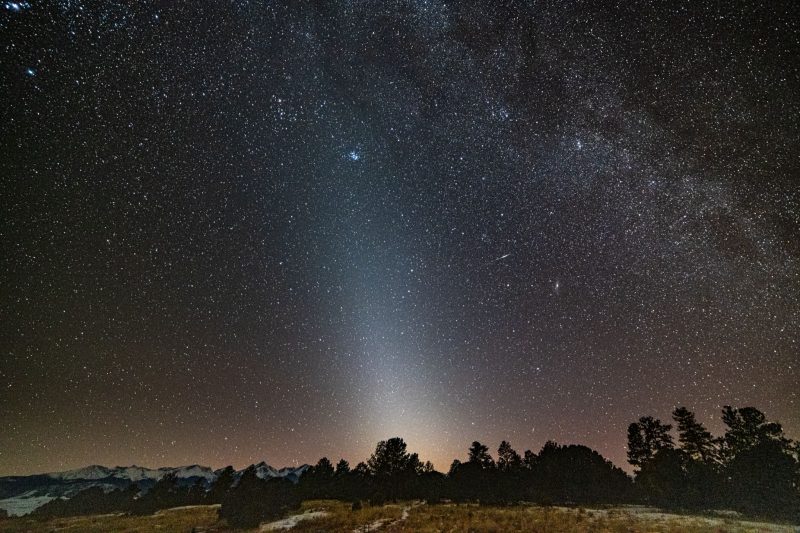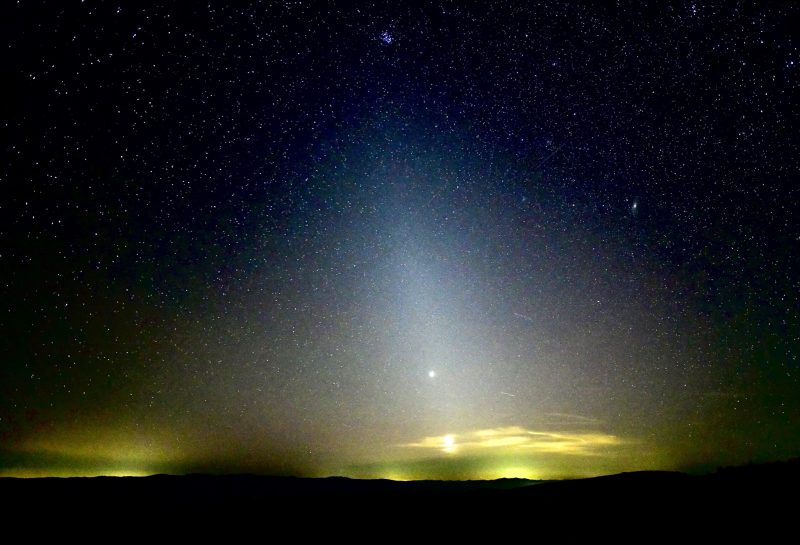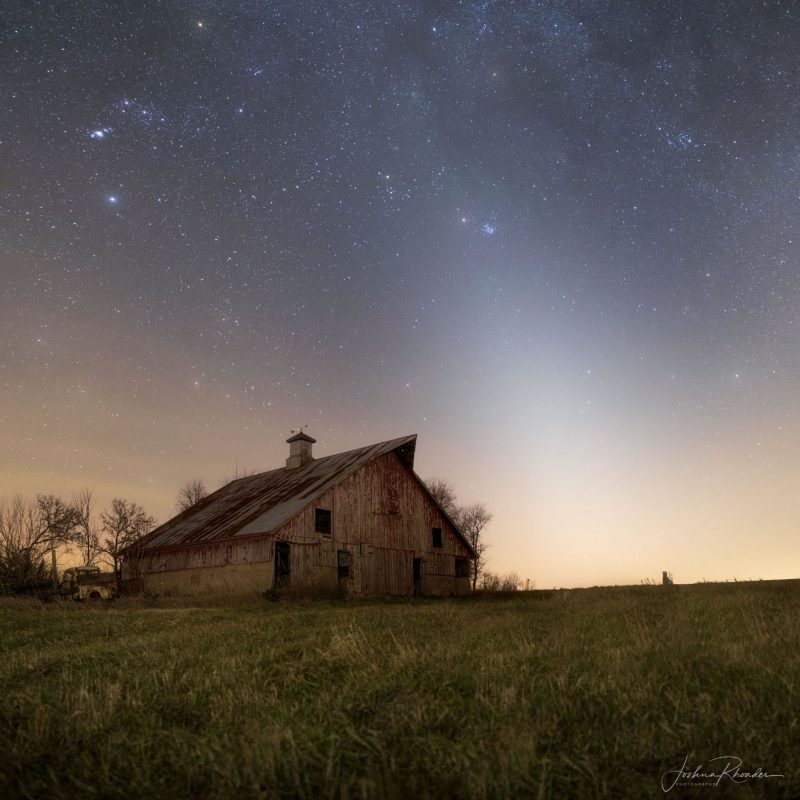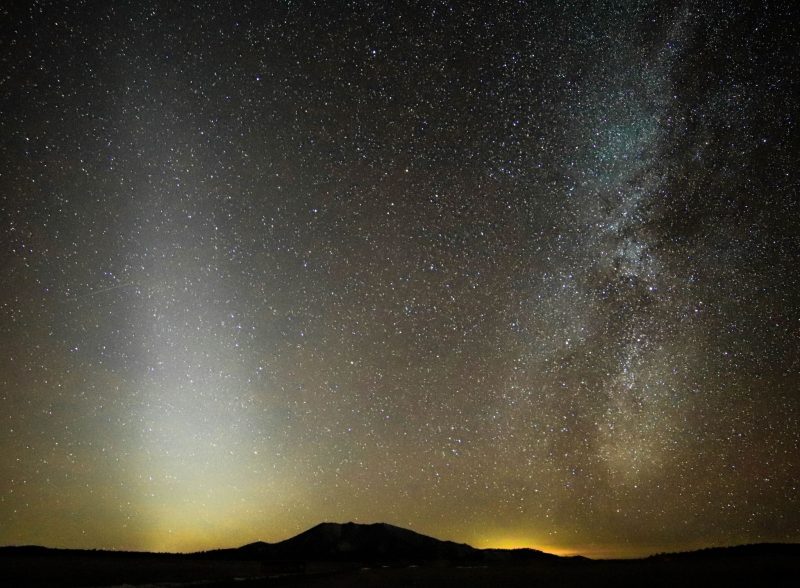
Zodiacal light around March equinox
The zodiacal light is a cone of eerie light in the sky just after evening twilight ends, or before it begins at dawn. If you’re in the Northern Hemisphere, you’ve got the best chance of seeing it in the west after nightfall during the weeks around the equinox on March 20. In 2023, the next new moon falls on February 20. So late February 2023 will feature lovely scenes of a young crescent moon, placed in the midst of the zodiacal light. What’s more, Venus and Jupiter – our sky’s two brightest planets – are now in the west after sunset, too. And they’ll also be visible with the zodiacal light, for most of its best weeks for viewing in 2023.

Around late February, through March, and into early May, the zodiacal light looks like a hazy pyramid of light extending up from your western horizon after evening twilight ends.
Some will call it the false dusk.
And northerners’ best chance to see this light in the east before dawn will come around the September equinox. Then it’ll go by the name false dawn.
Maybe you’ve seen the zodiacal light in the sky and not realized it. Maybe you glimpsed it while driving on a highway or country road at this time of year. Suppose you’re driving toward the west in springtime around 90 minutes after sunset. You notice what you think is the lingering evening twilight, or the light of a nearby town, over the horizon. Instead, you might be seeing the zodiacal light.
Note for Southern Hemisphere: Around late February, through March, and into early May – for you – the zodiacal light looks like a hazy pyramid of light extending up from your eastern horizon before morning twilight begins.
Bright planets – west after sunset – Venus and Jupiter!
The 2023 lunar calendars are still available. They are on sale now! Order yours before they’re gone!
What is this eerie light?
People used to think zodiacal light originated somehow from phenomena in Earth’s upper atmosphere. But today we understand it as sunlight reflecting off dust grains that circle the sun in the inner solar system. These grains were once thought to be left over from the process that created our Earth and the other planets of our solar system 4.5 billion years ago. In recent years, though, there’s been discussion about their possible origin in dust storms on the planet Mars. Read more: Do Mars dust storms cause the zodiacal light?
Whatever their origin, these dust grains in space spread out from the sun in the same flat disk of space inhabited by Mercury, Venus, Earth and Mars. This flat space around the sun – the plane of our solar system – translates on our sky to a narrow pathway called the ecliptic. This is the same pathway traveled by the sun and moon as they journey across our sky.
Ancient civilizations called the pathway of the sun and moon the zodiac or pathway of animals, in honor of the constellations seen beyond it. Hence the name zodiacal light.
The grains of dust are thought to range from about millimeter-sized to micron-sized, densest around the immediate vicinity of the sun and extending outward beyond the orbit of Mars. Sunlight shines on these dust grains to create the light we see.
Springtime? Autumn? What’s best?
The answer to that varies. For both hemispheres, springtime is the best time to see the zodiacal light in the evening. Autumn is the best time to see it before dawn. Look for the zodiacal light in the east around the time of the autumn equinox. Look for it in the west after sunset around the time of the spring equinox.
But, of course, spring and autumn fall in different months for Earth’s Northern and Southern Hemispheres. So if you’re in the Northern Hemisphere look for the zodiacal light before dawn from about late August through early November. In those same months, if you’re in the Southern Hemisphere, look for the light in the evening.
Likewise, if you’re in the Northern Hemisphere, look for the evening zodiacal light from late February through early May. During those months, from the Southern Hemisphere, look for the light in the morning.
How to see the light
The zodiacal light can be extremely bright and easy to see from latitudes like those in the southern U.S.
Meanwhile, skywatchers in the northern U.S. or Canada sometimes say, wistfully, that they’ve never seen it.
You’ll need a dark sky location to see the zodiacal light, someplace where city lights aren’t obscuring the natural lights in the sky. The zodiacal light is even milkier in appearance than the summer Milky Way. It’s most visible after dusk in spring because, as seen from the Northern Hemisphere, the ecliptic – or path of the sun and moon – stands nearly straight up in spring with respect to the western horizon after dusk. Likewise, the zodiacal light is easiest to see before dawn in autumn, because then the ecliptic is most perpendicular to the eastern horizon in the morning.
In spring, the zodiacal light can be seen for up to an hour after dusk ends. Or, in autumn, it can be seen for up to an hour before dawn. Unlike true dusk, though, there’s no rosy color to the zodiacal light. The reddish skies at dawn and dusk are caused by Earth’s atmosphere, while the zodiacal light originates far outside our atmosphere.
The darker your sky, the better your chances of seeing it. Your best bet is to pick a night when the moon is out of the sky. Although it’s definitely possible, and very lovely, to see a slim crescent moon in the midst of this strange milky pyramid of light. In the springtime, the best time to look for the zodiacal light – and avoid moonlight – is a few days after the full moon through a few days after a new moon.
If you see it, let us know! If you capture a shot of the zodiacal light, you can submit it here at EarthSky Community Photos.
Zodiacal light photos from our community



Bottom line: If you’re in the Northern Hemisphere, you can see the zodiacal light in February and March as a hazy pyramid of light extending up from the western horizon, beginning about an hour after sunset. Southern Hemisphere? Look east before dawn.
Enjoying EarthSky? Sign up for our free daily newsletter today!
The post Zodiacal light: All you need to know first appeared on EarthSky.
0 Commentaires